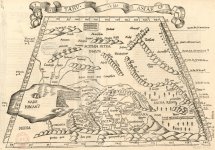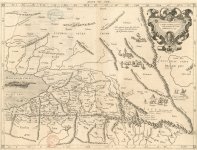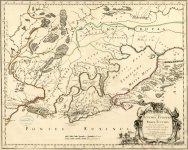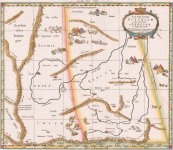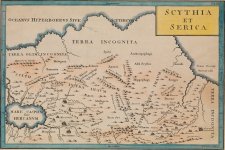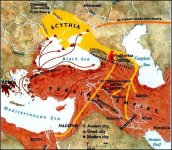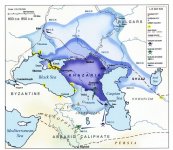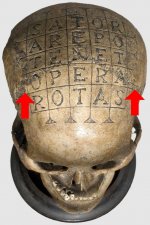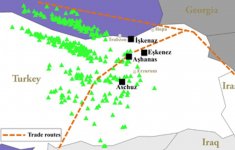A while back I ran into the map below. It's always interesting why geographical names change, but we rarely get any explanations. This transition from Scythia to Tartary is not an exception. As far as I understand, it's impossible to estimate the true size of Scythia due to the lack of available information. By that I do not imply that it was bigger than Tartary.
Contemplating the origins of the name "Tartary" you can't help it but think about words like Greek Tartarus, or our good old sticky tar. Searching for etymological origins did not produce any definitive answers. An opinion similar to the below one was expected:
I do understand that 200 and 500 years differ in duration, but what do we really know about our chronology?
I doubt that tent dwellers would bother building cities similar to Quinsay. But... we have Prester John to cover.
As far as I understand, various sources place Prester John in two major areas, with one being Africa, and the other one India. At first, Prester John was imagined to reside in India; tales of the Nestorian Christians' evangelistic success there and of Thomas the Apostle's subcontinental travels as documented in works like the Acts of Thomas probably provided the first seeds of the legend.
After the coming of the Mongols to the Western world, accounts placed the king in Central Asia, and eventually Portuguese explorers came to believe that they had found him in Ethiopia.
For the purposes of this article, it is irrelevant whether Prester John lived in Africa or Asia. This is a totally separate topic, and I plan on tackling it in the future.
This is what we have written on the above 1598 map titled Tartariae Sive Magni Chami Regni typus.

Criue RomoueI doubt too many of us have heard of this Criue Romoue. Meanwhile, if it was located somewhere in the Manchurian region, it could inflict some serious damage to the traditional narrative.

Prester John and D. ThomasSo, we have Prester John and some D. Thomas. Who could this D. Thomas be? Establishing who this D. Thomas was, could help us better understand historical time frames we are dealing with. It won't assist with dates much, but it could help out with figuring out who was alive at the time.
Searching for Prester John Thomas produced the following lines:
Our Eagle is the symbolism at its best, and in my opinion represents our realm. Just like I mentioned above, the eagle is a topic in itself, but to make a point, I do have to do a brief rundown on it. In my opinion, one will never truly understand its meaning, unless he/she draws our famous set of St. Peter's crossed keys by hand.

Seneschal: The word seneschal can have several different meanings, all of which reflect certain types of supervising or administering in a historic context.
In other words, these are the keys to our realm aka Theatrum Orbis Terrarum, and the Double Headed Eagle is the representation of this Theatrum Orbis Terrarum.
In the New Testament, praetorium refers to the palace of Pontius Pilate, the Roman "prefect" of Judea, which is believed to have been in one of the residential palaces built by Herod the Great for himself in Jerusalem. This is so convenient, for if the palace belonged to Pontius Pilate himself, there could have been one too many unpleasant questions.

Without being a part of the HRE aka Roman Empire, Pontius Pilate would have never had the double headed eagle on his palace, or on his "raised seat." We are not supposed to think that it was a throne. By the way, the palace, as well, is being called court in most places. Funny, but Pilate is not even a name, and he was a prelate, not a governor or procurator. Wouldn't it be something if a certain bishop contributed to the death of a certain Savior? Of course, a procurator would sounds much safer for the narrative and its creators. There is so much more to it...
As far as TPTB claims of the tremendous antiquity assigned to some of the double headed eagles, simply remember, that we live in the world of pre-1400's copies, rumors and hearsays. This world could be billions of years old, but our sources are very young.
This 2nd millennium BC eagle below is not that old, and can't be much older than any other double headed bird out there.

The narrative compilers will tell us otherwise, but their tools of trade do become more and more obvious:
The Destruction of the Temple and Signs of the End Times

In English it would sound something like this. During the pre-Flood days of Noah all human and animal (God created) DNA became corrupted with Nephilim DNA. It was not done through sex, but through knowledge and science.

Additionally, we know that text originals do not exist and first copies of the non-existent ancient originals were located after 1418. And even the 15th century itself is questionable, because 1482 and 1631 appear to mean the exact same date. For details see bullets #6, #7 and #10 here: Pompeiigate Scandal. Chronology Issues.
At the same time, it does appear that we did inherit some of the pre-JESUS EVENT knowledge. Here is where we can see it:
As far as the coming of Jesus in BC/AC goes... why was he sent here in first place. We are so used to the cliché answers similar to this one:

Apparently when the below 1179 book was written, they did not know about the Scythian Gold. Same old probables, perhapses and seemses in 1779.

I am not sure how to explain this royal inconsistency. How come the number and identity of the Scythian Kings provided to us by the today's PTB, does not match the PTB record from 1779?

As you can see, we do not know jack about anything. Yup, in 1779, the PTB was using the exact same tools of the trade. Additionally, it appears (if you reed between the lines) that the narrative prefers the word Thracian. Who needs Scythians?

And even the above 1779 "Kings of Scythia" list is incomplete, for here are three coats of arms of Scythian Kings and Queens. Only Thomyris is in the above 1779 cutout.
Scythians Ceneus and Minthia are covered here. As far as Tomyris goes, here is what the same 1779 book says.

Somehow coats of arms matched again. How could that happen?

1590 Source
Queen Tomyris Rejects Cyrus's Proposal of MarriageThis 1535-50 tapestry belongs to a series of five depicting scenes from the life of Cyrus the Great, legendary founder of the Persian empire. Herodotus tells of an attack by Cyrus on a distant land ruled by Queen Tomyris. Cyrus sacrificed a portion of his army to entrap the enemy by leaving them behind feasting on a large banquet. Tomyris’s troops, led by her son Spargapises, attacked Cyrus’s decoy troops, then stopped to consume the remains of the food and wine. Cyrus ambushed them and captured the queen’s son. Although Cyrus freed Spargapises, he immediately took his own life.

If this is what one of the Scythian towns really looked like (in addition to the foreground structures), we are in trouble.

TextsThere are plenty of older books talking about Scythians. Looks like they did not know much either. It does appear that they were a bit more exposed to the knowledge than we currently are, but it still was not close enough.
We also have interesting unverifiable pieces of information like this.
There are quite a few fascinating texts out there, but just like I said, it does not look like the info was authorized for disclosure even back then. I will post a few book links for those who want to dive in. Other ones you can search for yourselves.

Most of the golden coins are titled Thracian/Scythian or Indo-Scythian, but all of them are junk when compared to the alleged Scythian Gold craftsmanship. I do not think these coins have anything to do with the makers of the Scythian Gold.


KD: Unfortunately, I was unable to get to Argon, Tenduc, Serica and other interesting names mentioned on this 1598 map. As you can see, this article got out of hands and is too long as is. To be honest, I doubt that we have any information drastically different from the offered narrative. At the same time little differences do present themselves. For example, I noticed that where older texts say "Scythian", some of our contemporary ones use the word "Thracian".
I have to admit, that with Scythia, the PTB did a pretty good job purging the house. Yet, I do believe that there is some information waiting to be found out there.
Contemplating the origins of the name "Tartary" you can't help it but think about words like Greek Tartarus, or our good old sticky tar. Searching for etymological origins did not produce any definitive answers. An opinion similar to the below one was expected:
- Spelling was influenced by Latin Tartarus “Hell in Greek mythology.” - source
I do understand that 200 and 500 years differ in duration, but what do we really know about our chronology?
Tartary
Our history researching community is trying to find high levels of technology in Tartary. Instead we get texts talking about barbarian hordes roaming the area and living in tents. At the same time, such descriptions do not match the ones provided by people similar to Marco Polo. These descriptions are also not supported by the multitude of cities and towns present on the older maps of Tartary.- Tartaria, que Sarmatiam Asiaticam & vtramque Scythiam veterum comprehendit.
- KD: I can't get a meaningful translation for the above. If you have any ideas, please share below.
I doubt that tent dwellers would bother building cities similar to Quinsay. But... we have Prester John to cover.
Prester John: Africa vs. Asia
Prester John was a legendary Christian patriarch and king. Stories popular in Europe between the 12th and 17th centuries told of a Christian patriarch and king who was allegedly ruled over an Oriental Christian nation lost amid the pagans and Muslims. Those were the same lands in which the patriarch of the Saint Thomas Christians resided. The accounts are varied collections of medieval popular fantasy, depicting Prester John as a descendant of the Three Magi, ruling a kingdom full of riches, marvels, and strange creatures.As far as I understand, various sources place Prester John in two major areas, with one being Africa, and the other one India. At first, Prester John was imagined to reside in India; tales of the Nestorian Christians' evangelistic success there and of Thomas the Apostle's subcontinental travels as documented in works like the Acts of Thomas probably provided the first seeds of the legend.
After the coming of the Mongols to the Western world, accounts placed the king in Central Asia, and eventually Portuguese explorers came to believe that they had found him in Ethiopia.
For the purposes of this article, it is irrelevant whether Prester John lived in Africa or Asia. This is a totally separate topic, and I plan on tackling it in the future.
This is what we have written on the above 1598 map titled Tartariae Sive Magni Chami Regni typus.
- Argon. Once there was in Asia a Christian kingdom known to Prester John, and D. Thomas founded it in this place, so that it was in contact with the church of Rome, and was subjected to Rome through Prester John of Africa. Before it was defeated by the Goths, it was known as Criue Romoue.
Criue Romoue
- Source for the below excerpt
- Mentioned here - Latin
- Mentioned here - Latin
Prester John and D. Thomas
D. Thomas aka Judas aka Brother of Jesus.
Thomas the Apostle is commonly known as Doubting Thomas because he doubted Jesus' resurrection when first told of it; later, he confessed his faith, "My Lord and my God," on seeing Jesus' crucifixion wounds.- Thomas the Apostle
- According to the legend, Thomas was a skilled carpenter and was bidden to build a palace for the king. However, the Apostle decided to teach the king a lesson by devoting the royal grant to acts of charity and thereby laying up treasure for the heavenly abode. Although little is known of the immediate growth of the church, Bar-Daisan (154–223) reports that in his time there were Christian tribes in North India which claimed to have been converted by Thomas and to have books and relics to prove it.
- Didymus is the second name given for the Apostle Thomas in three places in the Gospel of John: 11:16; 20:24; 21:2.
- With Didymus and Thomas both meaning "twin," the real name here is Judas.
Searching for Prester John Thomas produced the following lines:
- The letter notes that John is the guardian of the shrine of St. Thomas, the apostle to India.
- An apocryphal letter, widely disseminated from 1165 on, from this ruler to the Byzantine Emperor Manuel I Comnenus made Prester John the guardian of the tomb of the Apostle Thomas in Mylapore.
- Reportedly a descendant of one of the Three Magi, Prester John was a generous ruler and a virtuous man, presiding over a realm full of riches and strange creatures (centaurs, Amazons, giants), in which the Patriarch of St. Thomas resided. His kingdom contained such marvels as the Fountain of Youth, and it even bordered the Earthly Paradise. Among his treasures was a mirror through which every province could be seen. There were no poor people, no dissensions, no vices in his dominions. The legend of Prester John (also Presbyter John) held such sway over the European imagination from the 12th through the 17th centuries that most historians believe it developed around some kernel of fact.
Time Frames
If Thomas the Apostle indeed founded Argon, he did so not that long after our narrative compliant AD 30/33 and prior to AD 72 (that's when he allegedly died). We all know that our chronology is all screwed up. IMHO, cannons were around prior to Jesus being born, for we can see cannons being used at the Battle of Alesia in AD 52.- 1533 painting by Melchior Feselen - Siege for Battle of Alesia
Battle of Alesia

We can also see the Double Headed Eagle of the the so-called Holy Roman Empire aka Roman Empire. There is a lot of baloney in the Eagle related Wiki piece, but Double Headers are for a different article. I will just say that we are dealing with years after the beginning of the Age of Discovery here, which is after AD 1400.
- KD: Roman Empire and Holy Roman Empire occupied the same time frame, IMO.
Our Eagle is the symbolism at its best, and in my opinion represents our realm. Just like I mentioned above, the eagle is a topic in itself, but to make a point, I do have to do a brief rundown on it. In my opinion, one will never truly understand its meaning, unless he/she draws our famous set of St. Peter's crossed keys by hand.
Seneschal: The word seneschal can have several different meanings, all of which reflect certain types of supervising or administering in a historic context.
In other words, these are the keys to our realm aka Theatrum Orbis Terrarum, and the Double Headed Eagle is the representation of this Theatrum Orbis Terrarum.
In the New Testament, praetorium refers to the palace of Pontius Pilate, the Roman "prefect" of Judea, which is believed to have been in one of the residential palaces built by Herod the Great for himself in Jerusalem. This is so convenient, for if the palace belonged to Pontius Pilate himself, there could have been one too many unpleasant questions.
- 1584 - Map of Jerusalem by Christianum Adrichom Delphum
- 1588 - Map of Jerusalem by Braun & Hogenberg
As far as TPTB claims of the tremendous antiquity assigned to some of the double headed eagles, simply remember, that we live in the world of pre-1400's copies, rumors and hearsays. This world could be billions of years old, but our sources are very young.
This 2nd millennium BC eagle below is not that old, and can't be much older than any other double headed bird out there.
The narrative compilers will tell us otherwise, but their tools of trade do become more and more obvious:
- MANDATORY READING: The PTB History Fabrication Tools
Jesus and Days of Noah
We have no way of knowing how many times the "Jesus Event" has taken place. May be the BC/AD one was the first one, and may be it was not. Our Bible is a questionable source, but we do not have too many JESUS EVENT related sources to start with. Anyways, there Matthew 24 goes.The Destruction of the Temple and Signs of the End Times
- 36: But about that day or hour no one knows, not even the angels in heaven, nor the Son, but only the Father.
- 37: As it was in the days of Noah, so it will be at the coming of the Son of Man.
- 38: For in the days before the flood, people were eating and drinking, marrying and giving in marriage, up to the day Noah entered the ark;
- 39: and they knew nothing about what would happen until the flood came and took them all away. That is how it will be at the coming of the Son of Man.
- 40: Two men will be in the field; one will be taken and the other left.
- 41: Two women will be grinding with a hand mill; one will be taken and the other left.
- Genesis 6.5 - And God saw that the wickedness of man was great in the earth, and that every imagination of the thoughts of his heart was only evil continually.
- Genesis 6.11 - The earth also was corrupt before God, and the earth was filled with violence.
- Genesis 6.12 - God saw the earth, and behold, it was corrupt, for all flesh had corrupted their way on the earth.
- Genesis 6.13 - And God said unto Noah, The end of all flesh is come before me; for the earth is filled with violence through them; and, behold, I will destroy them with the earth.
- Jubelees 7:24: And after this they (Nephilim) sinned against the beasts and birds, and all that moved and walked on the earth, and much blood was shed on the earth, and men continually desired only what was useless and evil.
In English it would sound something like this. During the pre-Flood days of Noah all human and animal (God created) DNA became corrupted with Nephilim DNA. It was not done through sex, but through knowledge and science.
- and much blood shed on the earth... hence things like the Lapiths battle with the Centaurs.
The Jesus Event
As you remember from the above, Prester John was a ruler presiding over a realm full of riches and strange creatures like centaurs. Centaurs (and other beings) were not created by God. Their existence should have contributed to achieving "As it was in the days of Noah" when "all flesh had corrupted their way on the earth". The JESUS EVENT was triggered, and we sure did have Jesus (BC/AD) who somehow paid for the sins of men. Once again we have no giants, no chimeras and no non-human humanoids that we know of. But... at some point "Two men will be in the field; one will be taken and the other left" and "Two women will be grinding with a hand mill; one will be taken and the other left".15th Century
The Age of Discovery should be renamed, for it really was the Age of Re-Discovery. IMHO, the reason Scythia became Tartary could be related to the JESUS EVENT taking place some time prior to the 1400s. These early 1400s were the time frame when everything started happening. Shortly after, droves of ruin artists started to "make stuff up".Additionally, we know that text originals do not exist and first copies of the non-existent ancient originals were located after 1418. And even the 15th century itself is questionable, because 1482 and 1631 appear to mean the exact same date. For details see bullets #6, #7 and #10 here: Pompeiigate Scandal. Chronology Issues.
At the same time, it does appear that we did inherit some of the pre-JESUS EVENT knowledge. Here is where we can see it:
- Greenland was ice free on the maps displaying inherited data.
- Maps with inherited data still had Hyperborea present.
- Africa was Sahara-free on the pre-JESUS EVENT maps.
- The lost city of Troy was x-marked on multiple maps sharing the inherited info.
- Japanese archipelago pre-event shape managed to bleed through.
- Antarctica was shown to us ice-free (if you prefer the globe).
- Pre-JESUS EVENT Sodom and Gomorrah were shown on the maps.
As far as the coming of Jesus in BC/AC goes... why was he sent here in first place. We are so used to the cliché answers similar to this one:
- We could never have a life worthy of God on our own. So Jesus lived a life without sin on our behalf. And then he died the painful death our sins deserve.
- By sacrificing himself for us on the cross, he took the punishment for all of our sins at once.
- This made him the ultimate sacrifice - once and for all satisfying the demands God’s justice required.
- KD: But... As it was in the days of Noah, so it will be at the coming of the Son of Man.
Scythia
The Scythia related narrative is so ambiguous and convoluted, that reading it requires tons of effort. Scythia was a region of Central Eurasia in classical antiquity, occupied by the Eastern Iranian Scythians, encompassing Central Asia and parts of Eastern Europe east of the Vistula River, with the eastern edges of the region vaguely defined by the Greeks. The Ancient Greeks gave the name Scythia (or Great Scythia) to all the lands north-east of Europe and the northern coast of the Black Sea. During the Iron Age the region saw the flourishing of Scythian cultures.- The Scythians - the Greeks' name for this initially nomadic people - inhabited Scythia from at least the 11th century BC to the 2nd century AD. In the seventh century BC, the Scythians controlled large swaths of territory throughout Eurasia, from the Black Sea across Siberia to the borders of China. Its location and extent varied over time, but it usually extended farther to the west and significantly farther to the east than is indicated on the map. Some sources document that the Scythians were energetic but peaceful people. Not much is known about them.
- By the 3rd century AD, the Sarmatians and last remnants of the Scythians were dominated by the Alans, and were being overwhelmed by the Goths. By the early Middle Ages, the Scythians and the Sarmatians had been largely assimilated and absorbed by early Slavs.
- The name of the Scythians survived in the region of Scythia. Early authors continued to use the term "Scythian", applying it to many groups unrelated to the original Scythians, such as Huns, Goths, Türks, Avars, Khazars, and other unnamed nomads.
Maps of Scythia
Unfortunately, it doesn't look like we have any decent maps of Scythia to work with. Everything we have was produced after 1400s. This is what I was able to find, but other than empty spaces and unfamiliar names, they are not really useful. None of these maps show us any signs of powerful infrastructure.Apparently when the below 1179 book was written, they did not know about the Scythian Gold. Same old probables, perhapses and seemses in 1779.
I am not sure how to explain this royal inconsistency. How come the number and identity of the Scythian Kings provided to us by the today's PTB, does not match the PTB record from 1779?
As you can see, we do not know jack about anything. Yup, in 1779, the PTB was using the exact same tools of the trade. Additionally, it appears (if you reed between the lines) that the narrative prefers the word Thracian. Who needs Scythians?
And even the above 1779 "Kings of Scythia" list is incomplete, for here are three coats of arms of Scythian Kings and Queens. Only Thomyris is in the above 1779 cutout.
Scythians Ceneus and Minthia are covered here. As far as Tomyris goes, here is what the same 1779 book says.
1590 Source
Queen Tomyris Rejects Cyrus's Proposal of Marriage
- In revenge, Tomyris led her troops against Cyrus. After defeating his army, she searched the battlefield for Cyrus’s corpse and exacted her vengeance by dipping the body in blood – giving him his “fill of blood” as she had vowed. Grand gestures and elaborate costumes were frequently employed in tapestry design. The figures are expertly situated in a landscape, which serves as the setting for other elements of the story. In this tapestry, Queen Tomyris rejects Cyrus's marriage proposal while his troops advance in the background.
If this is what one of the Scythian towns really looked like (in addition to the foreground structures), we are in trouble.
Texts
We also have interesting unverifiable pieces of information like this.
There are quite a few fascinating texts out there, but just like I said, it does not look like the info was authorized for disclosure even back then. I will post a few book links for those who want to dive in. Other ones you can search for yourselves.
Scythian Coins
After seeing what the PTB calls Scythian Gold, I am not quite sure whether our historians are that stupid, or simply want to disrespect their audience. Scythian masters were probably incapable of producing such junk even when they were drunk.- Gold stater Scythian Dynasts 50-25 B.C.
- Koson in alliance with Brutus - in mint state condition.
- KD: This is probably one of the better ones. You can see more here.
Most of the golden coins are titled Thracian/Scythian or Indo-Scythian, but all of them are junk when compared to the alleged Scythian Gold craftsmanship. I do not think these coins have anything to do with the makers of the Scythian Gold.
Scythian Settlements
This excavation segment should have gone to the Hall of Fame section. Scythians, for the most part, existed between 8th century BC and 2nd century BC. According to our mudflooded reality, their so-called settlements should have been under 15-20 feet of dirt. Instead we have this:- Unique Scythian settlement found in Subcarpathian Poland
- Excavations Of Scythian Settlement Kick Off In Ukraine's Poltava Region
- Expedition to the most ancient Scythian kurgan
KD: Unfortunately, I was unable to get to Argon, Tenduc, Serica and other interesting names mentioned on this 1598 map. As you can see, this article got out of hands and is too long as is. To be honest, I doubt that we have any information drastically different from the offered narrative. At the same time little differences do present themselves. For example, I noticed that where older texts say "Scythian", some of our contemporary ones use the word "Thracian".
I have to admit, that with Scythia, the PTB did a pretty good job purging the house. Yet, I do believe that there is some information waiting to be found out there.
-Tartaria olim Scythia-


